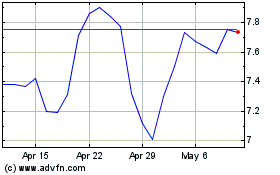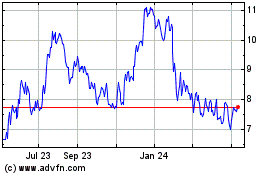Valley National Bancorp Announces Adoption Of Share Repurchase Program
February 21 2024 - 4:40PM

Valley National Bancorp (
NASDAQ:VLY) (“Valley”)
today announced that its Board of Directors approved a stock
repurchase program authorizing the purchase of up to 25 million
shares of Valley common stock. Valley’s current stock repurchase
program, unless terminated sooner, is set to expire on April 25,
2024. The authorization to repurchase under the new repurchase
program will be effective on April 26, 2024 and expire on April 26,
2026. The timing and actual number of shares repurchased will
depend on a variety of factors, including price, general business
and market conditions, and alternative investment opportunities.
Under the new repurchase program, repurchases
can be made from time to time using a variety of methods, including
open market purchases, all in compliance with the rules of the
Securities and Exchange Commission (SEC) and other applicable legal
requirements. The program does not obligate Valley to acquire any
particular amount of shares and may be suspended or discontinued at
any time at Valley’s discretion.
About Valley
As the principal subsidiary of Valley National
Bancorp, Valley National Bank is a regional bank with approximately
$61 billion in assets. Valley is committed to giving people and
businesses the power to succeed. Valley operates many convenient
branch locations and commercial banking offices across New Jersey,
New York, Florida, Alabama, California, and Illinois, and is
committed to providing the most convenient service, the latest
innovations and an experienced and knowledgeable team dedicated to
meeting customer needs. Helping communities grow and prosper is the
heart of Valley’s corporate citizenship philosophy. To learn more
about Valley, go to www.valley.com or call our Customer Care
Center at 800-522-4100.
Forward Looking Statements
The foregoing contains forward-looking
statements within the meaning of the Private Securities Litigation
Reform Act of 1995. Such statements are not historical facts and
include expressions about management’s confidence and strategies
and management’s expectations about our business, new and existing
programs and products, acquisitions, relationships, opportunities,
taxation, technology, market conditions and economic expectations.
These statements may be identified by such forward-looking
terminology as “intend,” “should,” “expect,” “believe,” “view,”
“opportunity,” “allow,” “continues,” “reflects,” “typically,”
“usually,” “anticipate,” “may,” “estimate,” “outlook,” “project” or
similar statements or variations of such terms. Such
forward-looking statements involve certain risks and uncertainties.
Actual results may differ materially from such forward-looking
statements. Factors that may cause actual results to differ
materially from those contemplated by such forward-looking
statements include, but are not limited to:
- the impact of
monetary and fiscal policies of the federal government and its
agencies, including in response to higher inflation, which could
have a material adverse effect on our clients, as well as our
business, our employees, and our ability to provide services to our
customers;
- the impact of a
potential U.S. Government shutdown, default by the U.S. government
on its debt obligations, or related credit-rating downgrades, on
economic activity in the markets in which we operate and, in
general, on levels of end market demand in the economy;
- the impact of
unfavorable macroeconomic conditions or downturns, instability or
volatility in financial markets, unanticipated loan delinquencies,
loss of collateral, decreased service revenues, increased business
disruptions or failures, reductions in employment, and other
potential negative effects on our business, employees or clients
caused by factors outside of our control, such as geopolitical
instabilities or events (including the Israel-Hamas war); natural
and other disasters (including severe weather events); health
emergencies; acts of terrorism or other external events;
- the impact of
potential instability within the U.S. financial sector in the
aftermath of the banking failures in 2023, including the
possibility of a run on deposits by a coordinated deposit base, and
the impact of the actual or perceived soundness, or concerns about
the creditworthiness of other financial institutions, including any
resulting disruption within the financial markets, increased
expenses, including FDIC insurance premiums, or adverse impact on
our stock price, deposits or our ability to borrow or raise
capital;
- the impact of
negative public opinion regarding Valley or banks in general that
damages our reputation and adversely impacts business and
revenues;
- greater than
expected costs or difficulties related to Valley's new core banking
system implemented in the fourth quarter 2023 and continued
enhancements to processes and systems under Valley's current
technology roadmap;
- the loss of or
decrease in lower-cost funding sources within our deposit
base;
- damage verdicts
or settlements or restrictions related to existing or potential
class action litigation or individual litigation arising from
claims of violations of laws or regulations, contractual claims,
breach of fiduciary responsibility, negligence, fraud,
environmental laws, patent, trademark or other intellectual
property infringement, misappropriation or other violation,
employment related claims, and other matters;
- a prolonged
downturn in the economy, as well as an unexpected decline in
commercial real estate values collateralizing a significant portion
of our loan portfolio;
- higher or lower
than expected income tax expense or tax rates, including increases
or decreases resulting from changes in uncertain tax position
liabilities, tax laws, regulations and case law;
- the inability to
grow customer deposits to keep pace with loan growth;
- a material
change in our allowance for credit losses under the Current
Expected Credit Losses (CECL) methodology due to forecasted
economic conditions and/or unexpected credit deterioration in our
loan and investment portfolios;
- the need to
supplement debt or equity capital to maintain or exceed internal
capital thresholds;
- greater than
expected technology related costs due to, among other factors,
prolonged or failed implementations, additional project staffing
and obsolescence caused by continuous and rapid market
innovations;
- cyberattacks,
ransomware attacks, computer viruses, malware or other
cybersecurity incidents that may breach the security of our
websites or other systems or networks to obtain unauthorized access
to personal, confidential, proprietary or sensitive information,
destroy data, disable or degrade service, or sabotage our systems
or networks;
- results of
examinations by the Office of the Comptroller of the Currency
(OCC), the Federal Reserve Bank (FRB), the Consumer Financial
Protection Bureau (CFPB) and other regulatory authorities,
including the possibility that any such regulatory authority may,
among other things, require us to increase our allowance for credit
losses, write-down assets, reimburse customers, change the way we
do business, or limit or eliminate certain other banking
activities;
- our inability or
determination not to pay dividends at current levels, or at all,
because of inadequate earnings, regulatory restrictions or
limitations, changes in our capital requirements or a decision to
increase capital by retaining more earnings;
- unanticipated
loan delinquencies, loss of collateral, decreased service revenues,
and other potential negative effects on our business caused by
severe weather, pandemics or other public health crises, acts of
terrorism or other external events; and
- unexpected
significant declines in the loan portfolio due to the lack of
economic expansion, increased competition, large prepayments,
changes in regulatory lending guidance or other factors.
A detailed discussion of factors that could
affect our results is included in our SEC filings, including the
“Risk Factors” section of our Annual Report on Form 10-K for the
year ended December 31, 2022 and in Item 1A of our Quarterly Report
on Form 10-Q for the quarter ended September 30, 2023.
We undertake no duty to update any
forward-looking statement to conform the statement to actual
results or changes in our expectations, except as required by law.
Although we believe that the expectations reflected in the
forward-looking statements are reasonable, we cannot guarantee
future results, levels of activity, performance, or
achievements.
|
Contact: |
Michael D. Hagedorn |
|
|
Senior Executive Vice President and |
|
|
Chief Financial Officer |
|
|
973-872-4885 |
Valley National Bancorp (NASDAQ:VLY)
Historical Stock Chart
From Dec 2024 to Jan 2025

Valley National Bancorp (NASDAQ:VLY)
Historical Stock Chart
From Jan 2024 to Jan 2025
